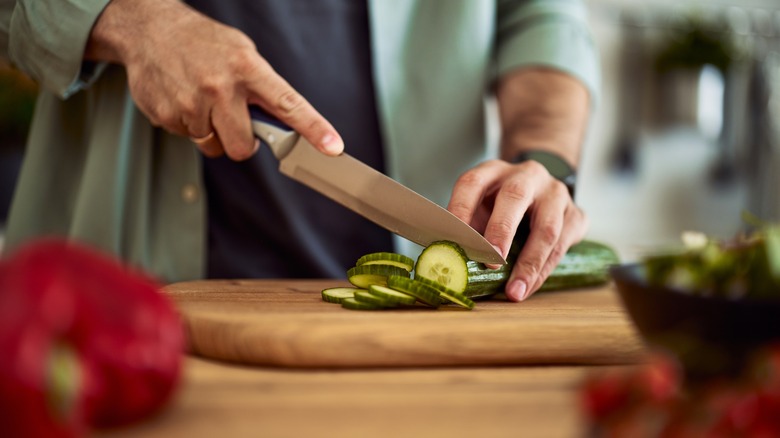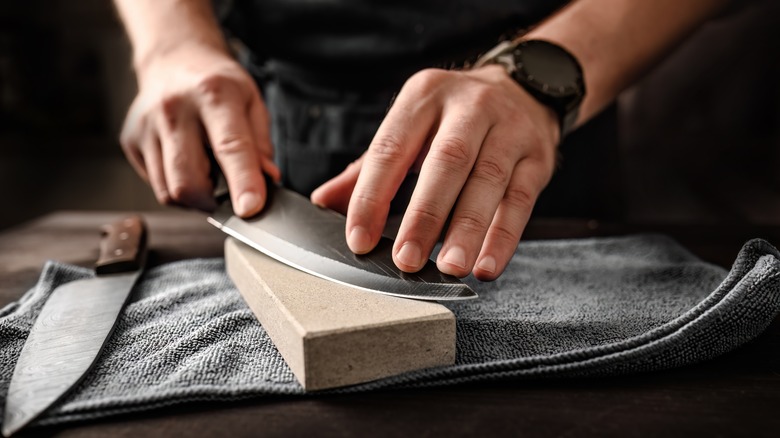The Tool You Need For Ultra Sharp Kitchen Knives At Home
We may receive a commission on purchases made from links.
If you've started to notice that your favorite knife has had a hard time slicing its way through vegetables, it's time to sharpen it. Dull knife blades are not only difficult to use in the kitchen, but are actually much more dangerous to use than sharpened blades, so regular sharpening is a must. You may have a honing rod, electric knife sharpener, or slotted sharpening tool, but none of these compare to the results you'll get from a whetstone.
Whetstones, also known as sharpening stones, have been used for centuries and all over the world, including Japan, England, and the United States. They are rectangular stone blocks that can be found naturally or manufactured. Wondering if you can just head outside and grab any old rock to drag your knife blade along? Not quite, as whetstones need to be porous in order to absorb a lubricant such as water or oil to work properly. Otherwise, you're dragging dry metal against dry stone, which can cause the blade to catch on the tiny crags, leading to dings, dents, and scratches. Similarly, you want a stone with a smooth surface, so it's best to buy an actual whetstone. Most whetstones will also have a coarse side for initial shaving and a fine side for more precise final touches.
Why whetstones are superior at sharpening knives
When you sharpen your knives, you are necessarily removing a small amount of metal from the blade; similarly to sharpening a dull pencil, the excess has to be shaved away. However, with other sharpening methods, it is incredibly easy to take off too much of the blade. This might not seem like a big deal at first, but if you are regularly sharpening your knives as you should, this can quickly diminish the blade to a sad nub, requiring you to replace it. Basically, with other honing and sharpening methods, it's too easy to make a very expensive mistake and ruin your knives.
One of the top reasons to use a sharpening stone is that they offer much more gradual, controlled sharpening, as you dictate how much pressure to use and the angle you hold the knife at. Though there's a big differences between sharpening German-style and Japanese knives, whetstones can be used on both, as well as paring knives and even pocket knives. With manual drag-through sharpeners, for instance, the angles are prefixed, so you can only use them on one style of knife.
How to use a whetstone
Before you even start sharpening, you'll usually need to wet your whetstone. Some tutorials and brands require you to totally submerge the block in water for anywhere from several hours to 45 minutes ahead of time. Others simply call for a splash of water. And of course, you'll need to apply oil if you're using an oil whetstone. Once your whetstone is sufficiently lubricated, you'll set up your station by placing the stone on a dry towel, or a stabilizing stand if your stone came with one. This will give your stone some grip so it's not sliding around while you sharpen.
Then, take your knife and hold it against the stone, working in small sections. With the coarse side of the stone facing up, slowly drag the blade away from you at a 15 to 20 degree angle while applying light pressure, only working in one direction. Repeat this a few times before moving to the next section of the blade until you've reached the top. Flip the knife so you can sharpen the other side the same way. Finally, flip the stone to the fine side and drag the full length of the blade across the stone on both sides for a final polishing and sharpening. Then, thoroughly wash the blade and be sure to fully dry the knife. Try not to get too enthusiastic with the sharpening, as you can always shave away more, but you can't put the blade back on once it's gone. Ready to try one out? The Sharp Pebble Premium Whetstone Knife Sharpening Stone is available for $39.99.

